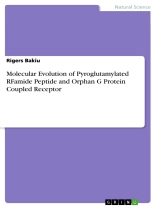Document from the year 2016 in the subject Biology – Evolution, grade: -, Agricultural University of Tirana, language: English, abstract: G protein-coupled receptors (GPCRs) are members of a large protein family that share common structural motifs, including seven transmembrane helices, and play pivotal roles in cell-to-cell communications and in the regulation of cell functions. GPR103 is an orphan GPCR that shows similarities with orexin, neuropeptide FF, and cholecystokinin receptors.
In humans, 26RFa/QRFP has been found to be an endogenous ligand for the orphan receptor, GPR103 and it is one of the RFamide peptides, which have been shown to exert important neuroendocrine, behavioural, sensory and autonomic functions.
All the information we have till know couldn’ be available if we didn’t know the evolution of this important proteins and the relative interactions, which were discovered recently to be important for the regulation of locomotor activity, sleep and these neuropeptides and receptors exert neuroprotective effect in Alzheimer’s Disease.
Anyway, there is a long way to be walked on, because there is a need of additional information, while studing the molecular evolution of these proteins and peptides.
What is the Molecular Evolution?
In the First chapter the readers can find all about this branch of science and the problems this branch had overcomed in order to bring to the scientific community the molecularisation of the evolution concepts.
In the following chapter to the readers is presented a descriptive overview of G-proteins and G-protein coupled receptor.
In the other chapters it is also presented 26RFA/QRFP and pyroglutamylated RFamide peptide receptor (QRFPR) molecular evolution, where it is described the molecular phylogeny and the functional implication. It is even shown the unique study regarding the presence on natural selection (positive or negative selection) during the evolution of QRFPRs in mammals and fish species.
In the end of the book are shown the recent important finding regarding the function and the role of QRFP and its receptor, together with the experimental approach applied to zebrafish and rodents.
Anyway, it is imperative to mention that all the available knowledge from experiments to these animals can be useful for the curation of disorders and other deseases like Alzheimer’s Disease, only if we could understand well their molecular evolution.
Über den Autor
Associate Professor Rigers Bakiu; Department of Aquaculture and Fisheries, Faculty of Agriculture and Environment, Agricultural University of Tirana; Lecturer/researcher and head of the Aquaculture and Fisheries Research Group












